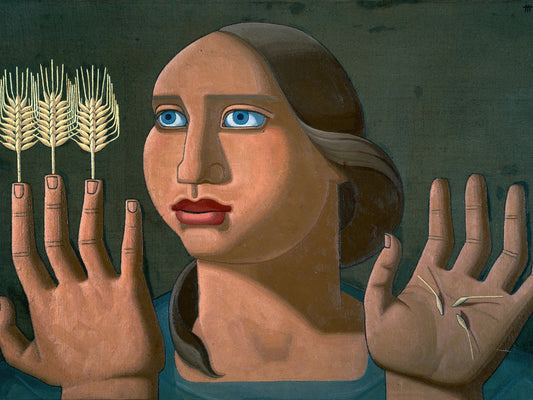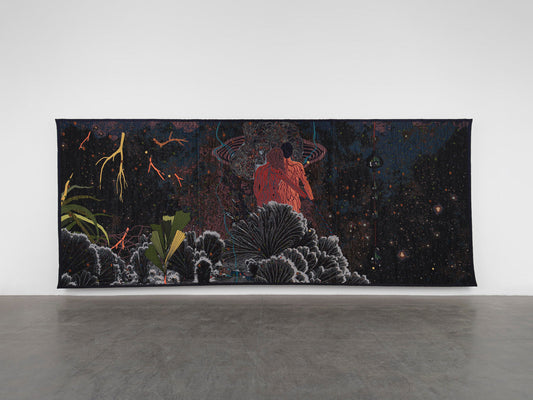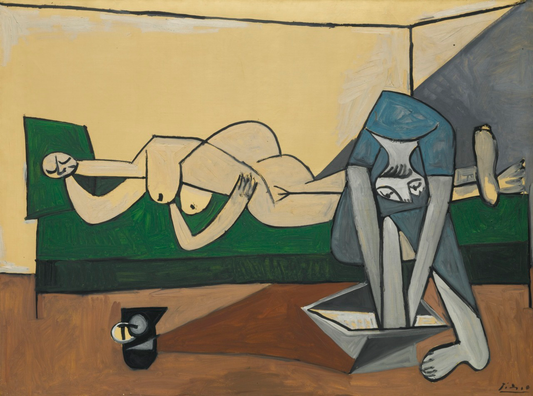Feature image: Kandinsky, Yellow, Red, Blue, 1925 via Singulart
Underrated, Must-Know Paintings by Wassily Kandinsky
Wassily Kandinsky is the painter everyone thinks they know. The father of abstraction. The man who gave us Composition VIII with its floating shapes and cosmic geometry. The Bauhaus star whose color theory revolutionized modern art. But Kandinsky's story is far richer than the flattened, graphic language he’s most associated with.
Beneath the clean lines and geometric precision lies a restless mind that traversed Russian folklore, spiritual mysticism, and explosive emotional states. Before he distilled form into abstraction, Kandinsky painted like a man on fire; his canvases swirled with chaotic landscapes, medieval fantasies, and a raw spirituality inspired by theosophy and synesthesia. Even at the height of his abstract experiments, many of his most personal and mighty works slipped through the cracks of mainstream recognition.

Here are eight underrated Kandinsky paintings that deserve a closer look. These pieces are not just stepping stones on the way to abstraction; they are vital keys to understanding Kandinsky as a painter of internal vision, spiritual yearning, and emotional complexity.
1. Colorful Life (1907)
Before he “invented” abstract painting, Kandinsky painted this bizarre, kaleidoscopic panorama of Russian folk life. In Colorful Life, figures in traditional dress, horsemen, towers, and trees all tumble together in a dazzling frenzy. Kandinsky once described the piece as “a fairytale dream,” and it feels like an ecstatic farewell to the representational world. You can already see his obsession with color as an expression of emotion and with line as a rhythm. This is an abstraction in chrysalis.

2. Improvisation 27 (Garden of Love II) (1912)
The Improvisations are often overshadowed by the more famous Compositions, but this piece is electric. The title hints at a personal narrative, possibly tied to Kandinsky’s relationship with fellow artist Gabriele Münter. Vibrant oranges and lavenders burst across the canvas, with fragments of figures and animals barely visible. It’s tender, chaotic, and intimate; abstract, but not detached.

3. All Saints I (1911)
Rarely discussed outside academic texts, All Saints I reveals Kandinsky’s spiritual leanings. Influenced by theosophy and Russian icon painting, it’s a haunting image of spectral figures, halos, and a celestial glow. This is more significant than geometry; it’s a revelation. A reminder that Kandinsky wasn’t just painting forms, but trying to channel something divine.

4. Composition VI (1913)
Often eclipsed by Composition VII and VIII, Composition VI is Kandinsky at his most operatic. He described this piece as evoking “the Flood, the Deluge, destruction, and rebirth.” It’s a swirling storm of lilacs, aquamarines, and blood-red streaks. But it’s also lyrical and musical, like a painting that hums. Kandinsky said he listened to Wagner while creating it, and you can feel the drama.

5. White Line (1920)
Created during his Bauhaus period, White Line showcases the pursuit of spiritual balance through pure abstraction. But there’s still mystery in this piece: that curving white path feels like a comet or a path through space. It has all the precision of his Bauhaus training, yet something cosmic seeps through. This exemplifies the interplay between motion, meditation, and transcendence.

6. On White II (1923)
While On White I receives most of the attention, the sequel is a more resolved and mature work. Its title isn’t a description of background, but a philosophical stance; white was, for Kandinsky, the color of silence and possibility. Against it, shards of color and form engage in what he called “the battle between life and death.” It’s a quiet storm, beautifully balanced and endlessly interpretable.

7. Sky Blue (1940)
Toward the end of his life, Kandinsky’s forms softened into biomorphic, floating shapes. Sky Blue is whimsical, almost like Miro, but don’t mistake it for a turn to lightness. The composition is masterful, each orb and squiggle suspended in celestial harmony. It’s dreamlike, yes, but built on the scaffolding of decades of visual experimentation.

8. Color Study: Squares with Concentric Circles (1913)
This is perhaps his most reproduced image, printed on mugs and tote bags, yet it's rarely discussed as a serious painting. It wasn’t meant to be “art” but a study for understanding how colors relate emotionally and spatially. But viewed on its own, it’s mesmerizing, a grid of tiny universes, each one vibrating with its own psychic charge. What started as a study ended up being one of Kandinsky’s purest visual poems.

The Overlooked Narrative
The artist's reputation as a cold theorist of color has often overshadowed his more mystical, passionate instincts. Many of his most moving works sit outside the typical narrative of abstraction. He painted visions, felt experiences, spiritual epiphanies, and deep emotional states. His obsession with music, color, and inner necessity wasn’t intellectual; it was visceral.
The beauty of his lesser-known works is that they break down this myth of Kandinsky as a cerebral formalist. They reveal a painter who was, in many ways, irrational: chasing feelings, dreams, visions, and spiritual energy. For him, painting was not a system. It was a necessity.

Why It Matters
In an age where Kandinsky has been flattened into a poster icon, revisiting these lesser-known pieces invites a fresh look at his legacy. He wasn’t just the Bauhaus maestro of geometry and grid. He was also a romantic, a mystic, and a dreamer.
These paintings aren’t side notes. They are essential to understanding the full arc of his artistry. They remind us that abstraction isn’t about reduction, but about expansion, of feeling, of thought, of what painting can be.
©ArtRKL® LLC 2021-2025. All rights reserved. This material may not be published, broadcast, rewritten or redistributed. ArtRKL® and its underscore design indicate trademarks of ArtRKL® LLC and its subsidiaries.





